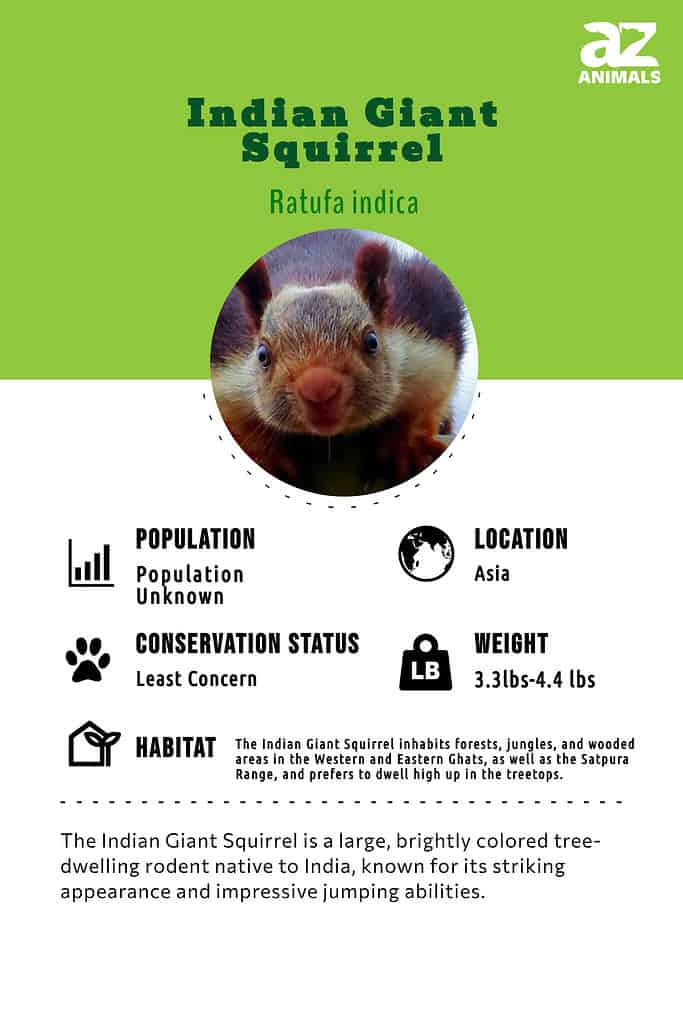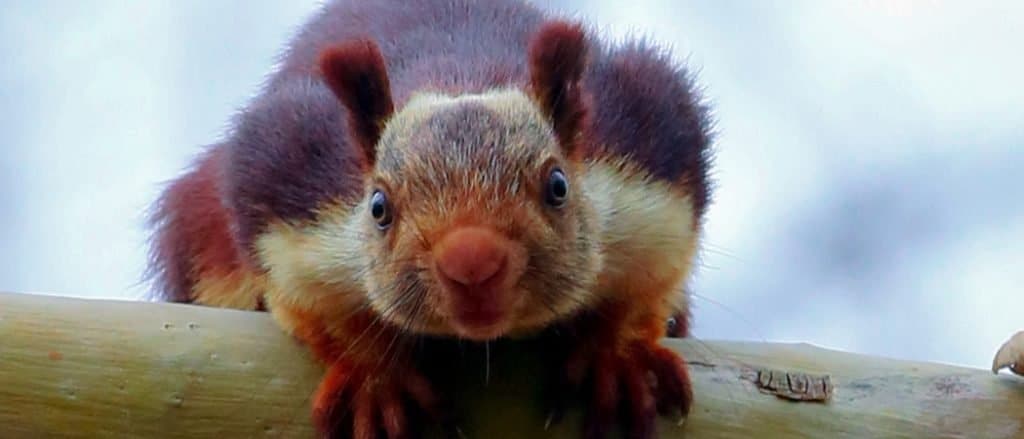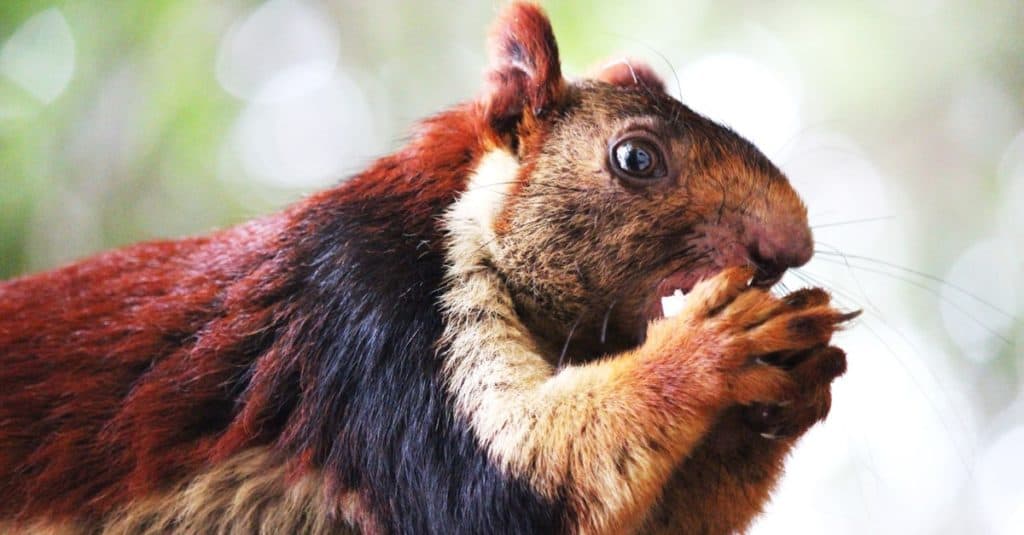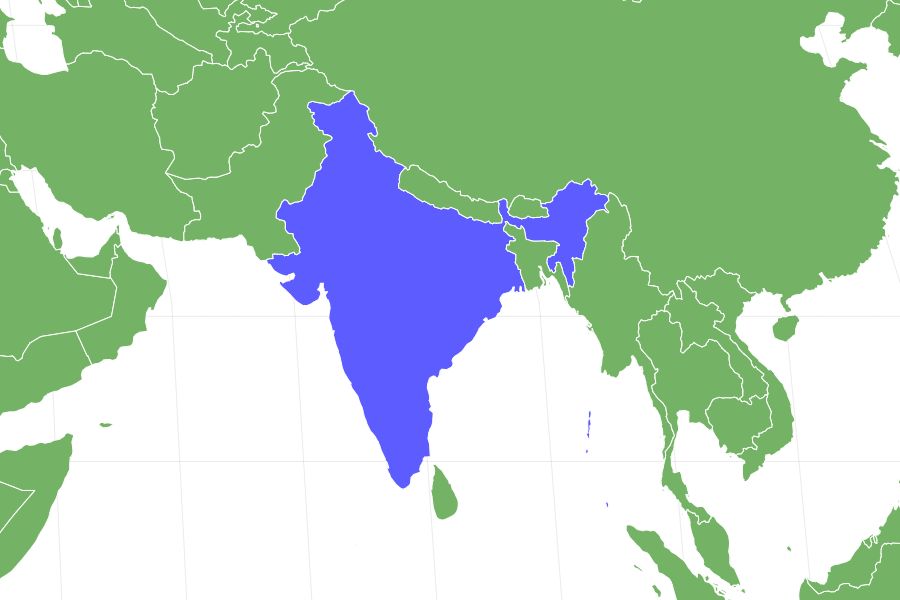Indian Giant Squirrel
Ratufa indica
Indian giant squirrels use their large tail to help them balance.
Advertisement
Indian Giant Squirrel Scientific Classification
- Kingdom
- Animalia
- Phylum
- Chordata
- Class
- Mammalia
- Order
- Rodentia
- Family
- Sciuridae
- Genus
- Ratufa
- Scientific Name
- Ratufa indica
Read our Complete Guide to Classification of Animals.
Indian Giant Squirrel Conservation Status
Indian Giant Squirrel Facts
- Prey
- insects, bird eggs
- Name Of Young
- pup, kit, kitten
- Group Behavior
- Solitary/Pairs
- Fun Fact
- Indian giant squirrels use their large tail to help them balance.
- Estimated Population Size
- unknown
- Biggest Threat
- Deforestation
- Most Distinctive Feature
- vibrant colors, large size
- Other Name(s)
- Malabar Giant Squirrel
- Gestation Period
- 28-35 days
- Litter Size
- 1-3
- Habitat
- Tropical forest
- Diet
- Omnivore
- Type
- mammal
- Common Name
- Indian giant squirrel
- Number Of Species
- 1
- Location
- South Asia
Indian Giant Squirrel Physical Characteristics
- Color
- Brown
- Red
- Black
- White
- Purple
- Skin Type
- Fur
- Top Speed
- 32 mph
- Lifespan
- 20 years
- Weight
- 1.5kg-2 kg (3.3lbs-4.4 lbs)
- Length
- Head & body 25.4cm-45.7cm (10in-18in), Tail 40.6cm-60.9cm (16in-24in)
- Age of Sexual Maturity
- 2-4 years
- Age of Weaning
- 6 months
View all of the Indian Giant Squirrel images!

“Indian Giant Squirrel is the largest squirrel in India!”
The Indian giant squirrel is a large rodent species native to India. More specifically, it is a type of tree squirrel. This animal’s appearance is unlike most other squirrel species due to its vivid colors and notable size. The Indian giant squirrel is also often called the Malabar giant squirrel. This remarkable mammal is one of the largest squirrels in the world.
5 Incredible Indian Giant Squirrel Facts!

Impressive leaps covering a distance of up to 20 feet can be propelled by the Indian giant squirrel.
©jp signature clicks/Shutterstock.com
- The tail of an Indian giant squirrel is typically longer than the length of its body.
- The Indian giant squirrel can propel impressive distances of 20 feet.
- Malabar giant squirrels are nicknamed “rainbow squirrels” due to their unique coloring.
- The Indian giant squirrel is the state animal of Maharashtra, India.
- Malabar giant squirrels are arboreal, spending most of their time in trees.
Scientific Name

Ratufa indica is the binomial name used to refer to the Indian giant squirrel.
©Ajmal roshan 007/Shutterstock.com
The scientific name for the Indian giant squirrel is Ratufa indica. It is alternatively called the Malabar giant squirrel and is also named “shekru” by locals in Maharashtra. They belong to the Sciuridae family and the Mammalia class.
The four subspecies of Indian giant squirrel are Ratufa indica indica, Ratufa indica centralis, Ratufa indica maxima, and Ratufa indica dealbata.
The meaning of the word “Ratufa” is “a genus of rodent” and refers particularly to Asian giant squirrels. The Latin word “indica” means “of India” and the word “squirrel” comes from the Greek “skiouros” which is defined as “shade tail.”
Evolution and Origins

This species is indigenous to India and its primary habitat is located in the Western Ghats, Eastern Ghats, and Satpura Range.
©jak ramu/Shutterstock.com
The species is native to India and is found primarily in the Western Ghats, Eastern Ghats, and Satpura Range. Its distribution extends up to Madhya Pradesh, which is around the 22nd parallel north.
Based on the wrist bones, it was determined that the animal is a member of a group of large flying squirrels.
Through evolutionary analysis that combined both molecular and paleontological data, it was discovered that flying squirrels likely evolved from tree squirrels over 31 to 25 million years ago, and perhaps even earlier.
Fossils have been found that trace the evolutionary development of tree squirrels as far back as the Late Eocene Epoch in North America (41.3 million to 33.7 million years ago), and in Africa and Eurasia during the Miocene Epoch (23.8 million to 5.3 million years ago).
Appearance and Behavior
These giant squirrels are distinguishable by their striking, multi-colored hues. The colors vary between individual squirrels. There is a common pattern of two to three shades, including white or cream, brown, black, red, maroon, and sometimes dark Fuschia. The deep shades are primarily seen along the body, while the lighter colors occur on the underside and the long, bushy tail.
They have strong claws to securely grasp branches. Males and females of this species have very similar appearances. There are a couple of contrasting characteristics to distinguish them from one another. Females are usually larger in size than their male counterparts by about three centimeters and have mammae for nursing their young.
Indian giant squirrels use their tail as a counterweight to help them balance on tree branches and their colors act as camouflage in their natural habitat. When threatened, they will also make themselves appear flat, blending in with tree bark and staying very still to evade predators.
These squirrels are hailed as giants because of their impressive size. They ordinarily weigh one-and-a-half to two kilograms or 3.3 to 4.4 pounds. Two kilograms is about five and a half times as heavy as a can of soup. The length of their head and body ranges from 10 to 18 inches, while their tail measures 16-24 inches. From head to tail, they are 29.5-30.7 inches or about two-and-a-half feet long, which is two times the height of a bowling pin.
The Indian giant squirrel and related species belonging to the Ratufa genus are categorized as Oriental Giant Squirrels. These large squirrels are all native to Asia. The genus-specific related species include the Black giant squirrel (Ratufa bicolor), Cream-coloured giant squirrel (Ratufa affinis), and Grizzled giant squirrel (Ratufa macroura.)
These giant squirrels are considerably larger than other tree squirrel species, such as the Eastern Gray squirrel and Red squirrel. Both of these squirrels measure less than 12 inches long and are under two pounds. Red squirrels weigh about the same as a hamster, while Eastern Gray Squirrels are three times that weight.
These giant squirrels are mostly solitary, but they sometimes stay with their mates for extended periods. A group of Indian giant squirrels is called a dray, scurry, or colony. They are normally shy and cautious of predators. Indian giant squirrels are diurnal, therefore they are most active in the daytime. They sleep in one of the multiple round nests they construct around their territory. Indian giant squirrels also contribute to their ecosystem by distributing seeds throughout their habitat after they have eaten and passed them. Squirrels can communicate with each other vocally with different calls and by twitching their tail.
Habitat
Malabar giant squirrels are endemic to South Asia. In the wild, they can be found specifically in India. Their habitat ranges through many states, including Karnataka, Andhra Pradesh, Madhya Pradesh, Gujarat, Chhattisgarh, Jharkhand, Maharashtra, Kerala, and Tamil Nadu. They prefer to live in tropical rainforest environments and are widespread within the Malabar rainforests. These squirrels spend most of their lives in trees. They are sometimes able to hide from predators on high limbs and in hollows of trees.
The four subspecies are also found in regions of India in forest habitats. Ratufa indica indica can be found in North Ghats and Central Western Ghats. Ratufa indica centralis is located across central India and Eastern India. Ratufa indica maxima lives primarily in Southwestern Ghats. Ratufa indica dealbata was local to Southern Gujarat although sadly, this subspecies is thought to now be extinct.
Predators and Threats
Humans are one of the biggest threats to these amazing creatures. Deforestation, logging, development, and the building of dams all lead to habitat loss and further fragmentation of populations. Some humans also hunt giant squirrels for their meat, which greatly contributes to a decline in the population.
The IUCN (International Union for Conservation of Nature) classifies this species as Least concern. This means the species, although declining, is not fast approaching threatened status. There are currently no conservation efforts to protect the Indian giant squirrel. However, there are several wildlife sanctuaries in India.
What eats Indian Giant Squirrels?
These squirrels have an array of natural predators. Wild cats such as leopards hunt them often. Birds of prey, including brown fish owls, and eagles, are frequent predators of the Indian giant squirrel. Some species of eagles known to hunt Indian giant squirrels are the crested hawk eagle, crested serpent eagle, and black eagle. Civets and snakes also prey on these squirrels.
What does an Indian Giant Squirrel eat?
Indian giant squirrels are omnivores and eat a variety of different foods. They are known to consume fruit, flowers, nuts, bark, seeds, insects, and bird eggs. They store their food in the treetops so they can easily access it. They stand on a branch and use their hands to eat while using their magnificent tail for stability.
Reproduction, Babies, and Lifespan
The exact period of mating season for these squirrels is not completely clear. Some research suggests it only takes place between the months of October and January, while other sources state it may occur year-round. The male Indian giant squirrels, also called bucks, compete with other males to mate with a female. This is a shared mating habit among many animal species. Researchers do not believe these squirrels mate for life, although they have been known to stick together for a while. Once a pair mates, gestation lasts between 28 and 35 days.
The female squirrel, also known as a doe, gives live birth to one to three young on average. The babies of this species are referred to as pups, kits, or kittens. When they are born, the pups do not have fur and are not yet able to see. They are nursed in nests built from leaves and twigs by the mother squirrel. The nests rest on branches in the treetops. The young are weaned at about six months old.
These squirrels have a lifespan of up to 20 years in captivity. In the wild, it is believed to be significantly shorter due to natural predators in their environment and threats from humans.
Population
The population size of these squirrels is currently unknown. The International Union for Conservation of Nature indicates the population trend is decreasing. The conservation status of this species is labeled as “least concern” on the IUCN Red List at this time.
View all 39 animals that start with IIndian Giant Squirrel FAQs (Frequently Asked Questions)
How long is the Indian giant squirrel?
On average, they are about two-and-a-half feet long from head to tail.
What eats Indian giant squirrels?
Leopards, eagles, owls, civets, snakes, and even some humans eat Indian giant squirrels.
Can Indian giant squirrels be pets?
While some places in the United States allow exotic pets, there is no known legal way of purchasing these animals from India. Also, the Wildlife Protection Act prohibits people from keeping them and other wild animals as “pets” in India.
Is the Indian giant squirrel endangered?
No, Indian giant squirrels are not endangered, though their population is declining.
Are Indian giant squirrels carnivores, herbivores, or omnivores?
Indian giant squirrels are omnivores, meaning they eat plants and some animals.
How big is a Malabar giant squirrel?
The Malabar giant squirrel can weigh between 3.3 and 4.4 pounds as an adult.
Where is the Malabar giant squirrel?
The Malabar giant squirrel is located in the rainforests of India.
Thank you for reading! Have some feedback for us? Contact the AZ Animals editorial team.
Sources
- Animal Diversity Web / Accessed June 12, 2021
- National Geographic / Accessed June 12, 2021
- Animalia / Accessed June 12, 2021
- Smithsonian Magazine / Accessed June 12, 2021
- Animal Spot / Accessed June 12, 2021
- iNaturalist / Accessed June 12, 2021
- The Animal Facts / Accessed June 12, 2021
- Pugdundee Safaris / Accessed June 12, 2021
- All Thats Interesting / Accessed June 12, 2021















